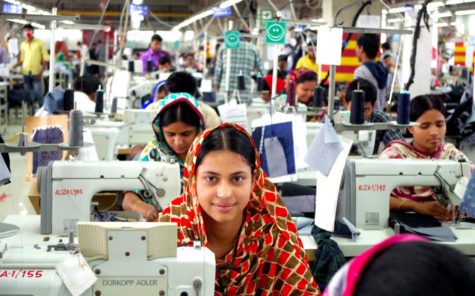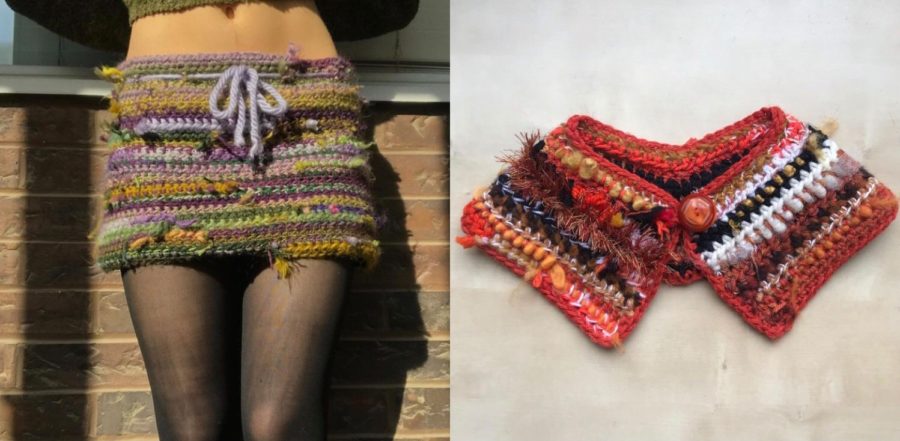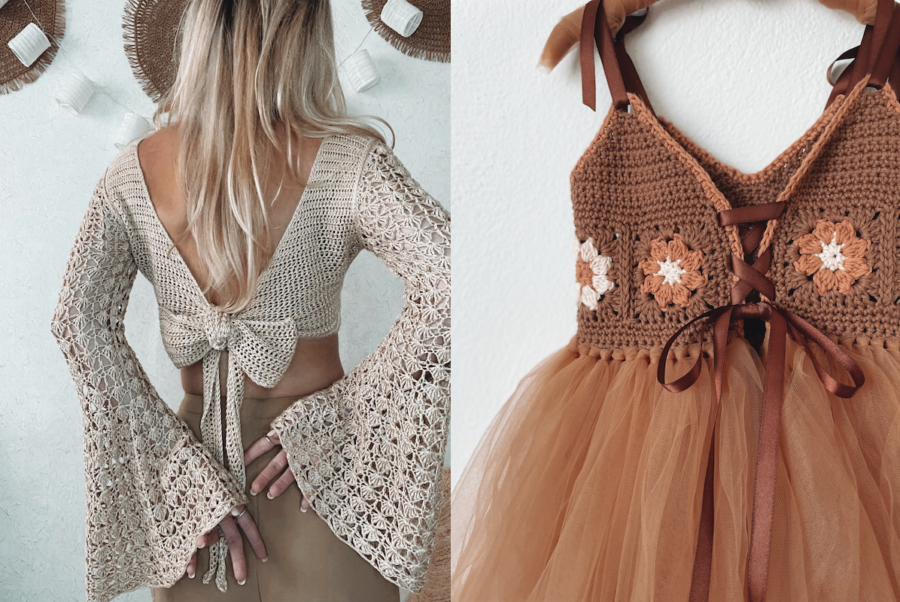The Rise of the Crochet Community and the Return to Slow Fashion
Have you ever heard of ‘slow fashion?’ Pay attention, as this new big social media trend might be the next answer to our pending climate crisis.
Here, a cute crochet mini skirt and stylish collar from Rosie Topp, is featured on her online shops on Instagram @place_to.be
In grade school, we all picked out our favorite hobbies to share to the class, explaining our favorite pastimes. Some of us picked sports, games, or crafting as our cherished hobbies, to balance out or school-time studies. With time, playing on the field becomes watching soccer games from stadium lines, and doodles become journaling. Yet still, millions of people lack the luxury of the extra time and resources to pursue such frivolous activities. Around the world, huge warehouses pay laborers wages ranging from $15-$21 daily, and they work just to put dinner on their plates. These workers forgo the relaxation and endure treacherous conditions and long working hours, completing menial labor.
Sadly, the fruits of thousands of people’s hard labor are the trend of today, and the trash of tomorrow — crushing the hopes and creativity of millions of creators and laborers. As our world continues in a constant progression of industrialism, we continue to exacerbate Earth’s climate crisis with landfills full of cheap materials, and disincentive the creativity and value of handcrafted products in the fashion industry.

Fast fashion has become our biggest adversary, hand in hand with materialism and exorbitant consumerism. Fast fashion has promoted the consumption of cheaply produced clothing and products, even those labeled with big company names and guarantees. Consequently, the average person’s thoughts and priorities neglect the fair treatment of people. This poses as a significant problem for those who are aware of harms that most ignore – like Rosie Topp. “I feel like the current narrative is trending towards, ‘fast fashion is bad unless you’re poor,’ but we don’t really think much about it beyond ‘it’s bad for the environment and worker’s rights’ …We don’t see the behind-the-scenes of garment creation. We don’t think about the people who dyed the fabric, the people who wove the cloth, the sewing machine that was created to make this dress you just bought, etc.” Topp said, illustrating the disconnected school of thought between consumers and producers- especially independent creators.
In the labor system, we subscribe to an oligarchical power scheme, allowing the rich to get richer and the poor to keep buying cheaper goods. While around 27 million people around the world suffer in sweatshops and fashion supply chains — their deaths, injuries and long-term illnesses continue to remain ignored — the wealth gap grows even wider, and mountains of cheap polyester garments continue to be shipped out. Whether this gap is created through the lack of availability of higher education, mental stress, or legislation, there are a lot of things we fail to consider on a day-to-day basis.
As previous studies have shown, specifically Dielle Lundberg and Julia Devoy’s article ‘The Aftermath of Fast Fashion,’ 66% of discarded clothing from fast fashion ends up in landfills. These “single use” garments take hundreds of years to decompose, and squander immense amounts of energy and time in production and discard. This creates detrimental impacts on global warming and climate change.
To combat this, consumers can instead support slow fashion and small businesses, or research where those brand name garments actually produce their advertised materials. Alas, most consumers go without researching the production of their goods, and it may be even harder to implement, considering how our minds are now acclimated to a shorter attention span and a need for change, in addition to the lack of consumer transparency. For the vast majority of large companies, and even smaller unknown brands, the most information you can usually get is a “made in xxx” country label in the inner rim, later to be removed due to its conveniently itchy and irritating material. Even so, companies associated with mainstream media and popular consumer demand, as well as those attached to celebrity names like the Kardashian’s brand, have often been accused of misleading consumers about their manufacturing process
Instead of propping up exploitative conglomerates, communities can look towards the sustainable alternatives of slow fashion, such as locally sourced products, or buy from small businesses with ample transparency about their products and services. The quickest solution to this search is the widely used platform used by millions of creators: social media.
Creators like Enida Advic believe, “Social media is everything to someone who is trying to set up a small business of any kind. It’s a platform where you can show off your work and market your products in any way that suits you. And you are the one directing everything! You don’t depend on anyone, and you can showcase your ideas exactly how you envision them.” This sense of freedom is commonly found on TikTok, YouTube, Instagram, and Facebook — which are all prominent places for viewing the creative content in handcrafting, bringing rise to the crochet community and return to slow fashion.
While there are still some hurdles, it is incredibly important to focus on the crochet craze and ensure that it doesn’t fall into the realm of microtrends. Micro trends are especially harmful, and are the biggest contributor to the rapid fast fashion waste, constituting a short outburst in infatuations toward a trend that people have little interest in after a few months. Even a slow transition to slow fashion holds more promise, as the reliability and personalized connections inch towards creating a better understanding of the importance of hand-crafted garments, and perhaps expand the world of DIY through content coverage.
TikTok, in particular, took the world by storm. Its short-form content and algorithm has provided crochet content creators with a platform to showcase their skills to massive audiences. The app’s algorithm favors engaging viewers and high-quality content, meaning creators with interesting or visually appealing content can easily reach a broader audience, gain new followers, and increase their exposure.
Like TikTok, Instagram reels have also become a source of inspiration for crochet content creators. These platforms are filled with innovative crochet ideas and patterns, techniques, and tutorials that inspire new creators to push their boundaries and experiment with new styles. Creators can also collaborate with other crochet enthusiasts, exchange ideas, and learn new techniques, which ultimately enhances their creativity and incentivizes slow fashion. The platform’s interactive nature allows creators to engage with their followers, respond to comments and messages, and create a sense of connection. This sense of community can be incredibly empowering and motivating for crochet content creators, as it helps them to feel supported and appreciated, as well as more engaged with the community.
Another plus side to this growing frenzy over crochet products is the opportunity for monetization and small business advertisement. Creators who have a substantial following on the platform can monetize their content through sponsorships, affiliate marketing, product promotions, or listings on places like the Instagram shopping tab. This not only provides them with an additional source of income, but also helps them to grow and improve the structure of their brands. For small businesses, social media is the best portable and widespread advertising platform. Visibility, brand awareness, and customer engagement, such as ‘behind the scene updates’ and ‘viewer-creator interactions’ are incredibly beneficial, as collaborations and trend riding is an integral part of expanding the business horizons of small businesses that sell crochet or crocheting as a hobby. Such brand awareness creates trust in creators and offers the transparency that mainstream companies lack.
The appreciation for the crochet craze runs on a two way lane; for instance, Maydeling Raquel Ramirez Borge enjoys the simplicity of creating. “I just think that handmade work is one of the best things there is, that you can use your hands to create and shape something that is fantastic and magical at the same time. Getting a shirt out of a thin and shapeless thread is what I like the most, and I am happy that there are many people who do the same job as me,” Borge said, proudly showcasing her quaint creations and festive summertime products on her Instagram account.
Between “rough days,” creators can more easily engage with their customers in new and exciting ways. Through direct messaging and other interactions, businesses can respond to customer comments and messages, offer support and advice, and build relationships with their customers. This engagement helps to build trust and loyalty, which is essential for small businesses that rely on repeat customers.
Even still, shorter content forms like TikTok, YouTube shorts, or Instagram reels are creating another problem due to their shorter duration. Linking the meticulous task of handcrafting like crocheting, knitting or sewing doesn’t necessarily mix with the shortened attention spans of people working to make products. Because short form content is so short, people are less likely to remember what they see, and creators have difficulty condensing and creating enough content to be supported by networking algorithms. This also comes with the issue of large companies tracking viewership. When you open almost any social media app, how many profiles you click, how many times you watch or click a post, and how often you spend searching specific tags, are all noted in the algorithms and fed into large databases. The nature of the digital footprints and flimsy laws regarding the sale of personal data creates a problematic breach of privacy. Services like Nord VPN and other VPN protectors can aid in some levels of protection, but they are only viable options for people who are able to afford it.
Social media outlets also unfortunately create a smaller problem with the lack of protection for creators. Fast fashion encourages “stealing” the most popular designs in order to create the most profit cheaply, meaning that they discredit the original creators.
“I feel that (fast fashion) overvalued the great work of people like me, who do unique things for the public, and that they replicate it in such a shameless way and with such low prices, making what we do not be valued as much,” Borge continued.
Oftentimes, creators of name brands and small businesses alike can see their ideas copied on cheaply produced goods. Even so, small businesses and independent creators face more of the hurdles with their lack of agency over such problems. Larger brands and companies will also undercut smaller artists by labeling and paying them like mainstream producers.
“This is a HUGE topic in the fiber arts community, and especially the crochet community! Bigger brands definitely seem to take advantage of fiber artists in exchange for free yarn, but artists should be getting paid for their hard work as well, especially when there’s a full set of requirements, terms and conditions, deadlines, etc.,” said Breanne Greenfield –another social media based independent creator, explaining another point about company transparency and sourcing information.
Unfortunately even with all the benefits of independence, social media algorithms still cannot serve all creators equally, leaving yet another hole for smaller brand names looking to make it big. Between different creators, the algorithm doesn’t necessarily show the same attention to two similar accounts, so it is partially based on luck. In the semi-lucrative business, no one truly knows what makes one specific brand more popular and successful than another.
For some people, slow fashion will remain an individual hobby and personal goal towards creating a more healthy relationship with the planet Earth. It also aids in creating the balance in consumption of goods — from students, to content creators, to anyone around the world who is interested in handcrafted garments.
“It gave me the sense of self, who I am and who I want to be. It also gave me the means of expressing my creativity and the ability to make something with my own hands. The satisfaction in that has no price!” Advic added. Handcrafting combines elements of skill, personal style, community, and environmental significance, all combined. Through this purposeful pastime, creators add a meaningful piece into their closets, reusable for many years. Even at the end of a garments’ lifetime, the yarn can be unraveled, re-dyed, and repurposed.
Small business and social media trends also offer a new range of variability in which consumers can directly demand custom products, creating a consistent brand presence across social media platforms. Small businesses are not necessarily bound by the concept of fast fashion “popular demand” and can instead, focus on and prioritize personal demands. By posting high-quality images of their products and using relevant hashtags, small businesses can attract new followers, who may be interested in their products. By partnering with other small businesses, crochet and textile businesses can share their audiences and also gain exposure to new customers. Collaborations can take many forms, from joint giveaways to co-creating products. These methods can be an effective way for small businesses to expand their reach and cater more to the community.
Whether through finalized products, DIY kits, pattern pieces, or just simple content showcased by proud handcrafters, slow fashion deserves more of our respect and values. We can show our support to the crochet community through our awareness, research, and appreciation, as well as advocate against policies that allow fast fashion to thrive.
Be sure to take a look at the participants of this article’s research, as well as news and information regarding slow fashion that might creep up into your feed!
Whether through finalized products, DIY kits, pattern pieces, or just simple content showcased by proud handcrafters, slow fashion deserves more of our respect and values.
Eyenain Misgar is a Spotlight Editor for 'The Science Survey.' Eyenain finds the most appealing aspect of journalism to be the coverage and inspiration...












